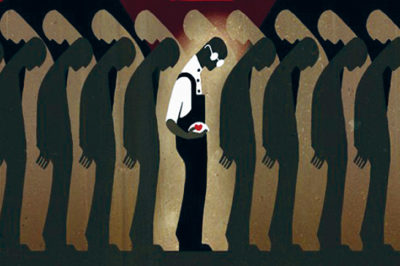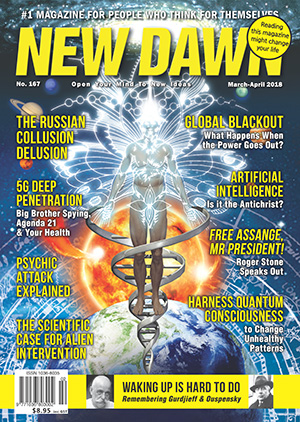From New Dawn 167 (Mar-Apr 2018)
In the spring of 1915 the writer and journalist Peter Demianovich Ouspensky, a familiar name in Russian Theosophical circles, gave a series of lectures in Moscow about his recent “search for the miraculous” in Egypt, Ceylon, and India. Ouspensky, a popular author on occult themes, had gone East in search of “schools,” teachers from whom he could learn a knowledge “unlike anything known or used by us” – the modern, scientific West that is.1 Such knowledge, he believed, was the only thing that could offer a way out of the “labyrinth of contradictions” that make up modern life. Ouspensky was convinced that through this knowledge the “thin film of false reality” – of money, prestige, and the pursuit of power – that we take to be real, could be dissolved and another reality, that of the “miraculous,” could be revealed.2
Ouspensky did not find what he was looking for in the East. He met many interesting people and travelled to many sacred places, but in the end he had to admit that the miraculous had eluded him. But the miraculous was not to be balked. It was waiting for Ouspensky, and if he could not find it, it would come to him.
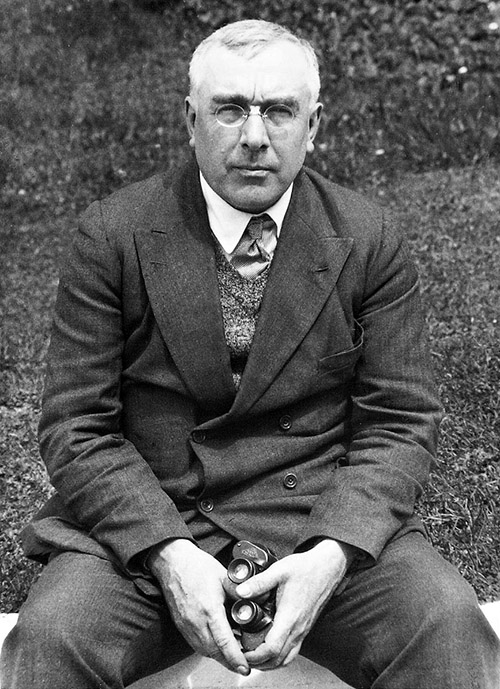
Apparently, it was much closer than he thought. In fact, it appeared one afternoon in small café in a busy Moscow side street in the form of a “certain G., a Caucasian Greek,” whom Ouspensky remembered was the author of a strange ballet, “The Struggle of the Magicians,” a notice for which he had recently seen in a newspaper. He had agreed to this meeting only after one of G’s students, who had attended his lectures, had persisted in inviting him. Ouspensky had finally said yes to his requests just to stop his pestering. Ouspensky had had his fill of gurus and had returned from the East not a little disillusioned. His interest in Theosophy and other occult ideas was more than a little bruised, and he was sure all that would come from this encounter was more confirmation of his scepticism. But what he learned from this “certain G.” changed all that.
Ouspensky’s “certain G.” was the enigmatic Armenian esoteric teacher George Ivanovitch Gurdjieff. Together the two were responsible for introducing to the West a startlingly new and often brutally demanding system of self-development, what Ouspensky later dubbed “the psychology of man’s possible evolution.” Today it’s widely known as the Fourth Way – to differentiate it from those of the fakir, yogi, or monk – or, more familiarly, “the work.” Gurdjieff had already been working with groups of students in Moscow for a few years before stage managing this meeting and had purposefully set out to attract Ouspensky, whom he wanted to secure as a Plato to his Socrates, that is, as a good interpreter and expositor of his ideas. He had his students read Ouspensky’s books – the most impressive of which, Tertium Organum, about higher dimensions and mystical states of consciousness, had made his name – and then sent them out to ensnare the philosopher. If Gurdjieff’s students had not been successful in getting a wary Ouspensky to this café, there is every chance that “the work” might not have survived the historical eruptions – World War I, the Bolshevik Revolution and Russian civil war – that were the backdrop to Ouspensky’s true encounters with the miraculous.
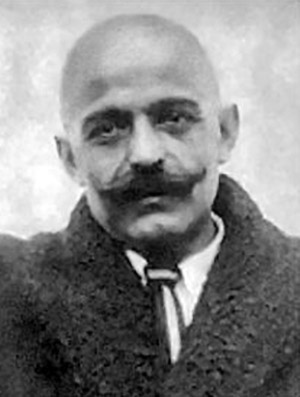
Ouspensky was immediately impressed by Gurdjieff as a man who knows, a man, that is, who possessed the kind of knowledge that he had sought in the East. But although it soon became clear through their conversation that Gurdjieff was as well versed in religious, spiritual, and mystical traditions as he was, and was equally if not better travelled – indeed, he had been to places that Ouspensky had only wished to visit – there was something more. Gurdjieff himself had a strange undeniable presence. This man “of an oriental type” with a “black moustache and piercing eyes” astonished Ouspensky because he seemed to be purposefully poorly disguised. His face, which reminded Ouspensky of “an Indian raja or Arab sheik,” did not suit the black overcoat and bowler hat he wore, as did the many small businessmen that frequented the place. But his disguise was obvious, and Ouspensky was not a little disconcerted to feel that while he knew this certain G. was in disguise, he also knew that he had to pretend that he wasn’t, and that he had to carry on their conversation as if all was perfectly normal. This was Ouspensky’s first experience of the kind of psychodrama and “role-playing” that Gurdjieff performed with his students and which, in the end, would drive him away.
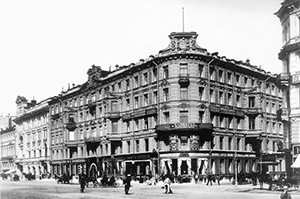
But that was in the future. From that meeting until the summer of 1918, while Russia exploded into chaos, Ouspensky submitted himself to Gurdjieff’s tutelage and began to learn the “system,” a story he tells in his posthumous masterpiece, In Search of the Miraculous. And if Gurdjieff himself impressed with an aura of strength and knowledge, the system he began to unfold to an increasingly ensnared Ouspensky made an even greater impact. It was logical, consistent, based on experience and observation and free of the kind of wishful thinking that Ouspensky had found in many other mystic teachings. In fact, it was almost specifically designed to attract a rigorous, critical intellect that had recently shorn itself of much of its romanticism. Whether this was so or not, in Ouspensky’s case it’s exactly what happened.
The Teachings
What was Gurdjieff’s teaching? When Ouspensky remarked on how life in big cities like London, where he had just been, was becoming more mechanical and increasingly turning people into machines, Gurdjieff corrected him. They already are machines, he said, and would be whether they lived in the city or not. “This must be understood,” Gurdjieff impressed on Ouspensky. “All the people you see, all the people you know, all the people you may get to know, are machines, actual machines working solely under the power of external influences.” Ouspensky was already concerned about the increasing mechanisation of modern life, but he believed that some things, the most important ones – thought, art, poetry – could stand against it. Gurdjieff told him he was wrong. These, too, can be and regularly are performed mechanically. He put up a fight, but it was not long before Ouspensky, himself a novelist and short story writer – witness Strange Life of Ivan Osokin and Talks With the Devil, respectively – agreed.
The most important question Ouspensky asked Gurdjieff was whether it was possible to stop being a machine? It was, Gurdjieff told him, but it was difficult and demanded much knowledge and effort. The problem is that man is asleep. What we take to be our waking consciousness is really just another kind of sleep; true wakefulness is something different. There are many reasons for this sleep. One is that human beings possess different minds or “centres,” each responsible for certain actions and behaviours. We have an intellectual, an emotional, a moving, and an instinctive centre, and also two “higher centres” from which we are cut off by our mechanicalness. When these work properly, all is good, but in modern man the centres are all confused, with one doing the work of another or stealing energy from other centres in order to do its own work. What is important for wakefulness is that each centre do its own work with its own energy and that all are in balance. It is then that the insights of “higher centres” can reach us. Such balancing is what Gurdjieff taught and his aim was to produce the “harmonious development of man.”
Another hurdle to wakefulness is that while we believe we possess a single “I,” a stable, reliable ego, the truth is that “we are legion,” as the man possessed by devils tells Jesus in Mark 5:9. We are not one but many. Our “I’s” shift with every mood. We decide to get up early tomorrow; when the alarm bell rings we turn it off and stay in bed. We decide to start a diet; when dinner time arrives we conveniently forget this. Our “I’s” shift because we are subject to a kind of hypnosis Gurdjieff called “identifying.” We lose our identity, our “I-ness” by giving it over to practically everything around us. Some of these disparate “I’s” can congeal into what is known as “false personality,” a picture of ourselves that allows us to ignore the contradictions that run rife through our lives but which are obvious to others.
Personality – let alone a false one – is itself an obstacle. Gurdjieff taught that we are made of two parts, what he called “essence” and “personality.” Essence is our own, it is what we are born with and is through essence that we can grow. But around essence accumulates our “personality.” This is what we learn or imitate from others and is the face we turn towards “life.” The problem is that personality becomes too rich, obscuring essence, rather like a bad orange whose thick rind covers a small bit of fruit. The aim of Gurdjieff’s system was to break down personality, to dismantle it and through the suffering that this entails, enable essence to grow.
Self-Remembering
What impressed Ouspensky most was what Gurdjieff had to say about a strange third state of consciousness he called “self-remembering.” There are four states or levels of consciousness. First there is sleep, which we pass through each night. Then there is what we normally call “waking consciousness,” but which is really another layer of sleep. This is our usual mechanical state of consciousness, which we falsely believe to be true consciousness. True consciousness, “self-consciousness,” only comes in the third level, what Gurdjieff called “self-remembering.” Normally our attention is directed outwards, toward the external world. Because we usually “identify” with things outside us, we “forget” about our own inner world. We forget that it is “I” – “you” – who is conscious and is actually in this moment engaged in the act of perceiving the world. Gurdjieff knew, as did Edmund Husserl, the founder of phenomenology, the philosophical method that gave birth to existentialism, that perception is intentional. He also knew that the less intentional and more passive we remain, the deeper our forgetfulness becomes.
Self-remembering is having the awareness of your own self, the observer and what you are observing, simultaneously. It is essentially a vivid sense of your own being, the fact that “you” exist, here and now. It can come to us out of the blue, and many examples of self-remembering can be found in literature; the episode of the madeleine in Proust’s Remembrance of Things Past is a classic example, although, of course, Proust doesn’t use the term “self-remembering.” In this sense, Gurdjieff shares much with the existential philosopher Martin Heidegger, who also believed that man’s greatest problem is what he called “forgetfulness of being,” loss of the sense of our own existence. Gurdjieff and Heidegger also arrive at the same remedy for this. Our forgetfulness or sleep in the face of being can be broken by a vivid grasp of the reality of our own finitude – our death – a medicine Heidegger prescribes in Being and Time and with which Gurdjieff agreed in his own perplexing jawbreaker of an esoteric masterpiece, Beelzebub’s Tales to His Grandson.
There is a fourth state of consciousness, “objective” or “cosmic consciousness,” in which we perceive reality as it truly is, and not obscured by our subjective perspectives. It is then that certain laws, the Law of Three and the Law of Seven, and an understanding of Gurdjieff’s version of the Great Chain of Being, the Ray of Creation, among other otherwise incomprehensible things, seem obvious. But this is far beyond us at present and actually useless to us unless we can maintain “self-remembering” for more than brief flashes.
Ouspensky’s Breakthrough
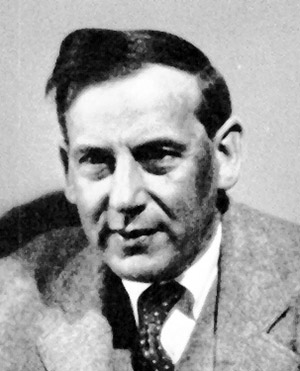
These and other ideas first became widely known when Lady Rothermere, wife of a powerful British newspaper baron, rescued Ouspensky from White Russian refugee status in Constantinople by inviting him to London all expenses paid. An English translation of Tertium Organum – which Ouspensky knew nothing about – had become a surprise best-seller in America and England; one of its most devoted readers was Lady Rothermere, and a handsome royalty check accompanied her invitation. In September 1921 Ouspensky found himself in Lady Rothermere’s luxurious St. John’s Wood salon, addressing an audience that included T. S. Eliot, Aldous Huxley, Algernon Blackwood, Gerald Heard among other London literary luminaries. Also among his listeners were A. R. Orage, editor of the leading journal of ideas The New Age, and Maurice Nicoll, a successful Harley Street physician and C. G. Jung’s main disciple in Great Britain. By the end of Ouspensky’s lecture on the system he had learned from G. – which surprised all and disappointed some who had come to hear something more along the lines of Tertium Organum – both Orage and Nicoll would become his students.
Ouspensky’s tutelage of Orage was short-lived. In February 1922, Gurdjieff himself arrived in London. As always, the appearance of this remarkable man caused disruption. Ouspensky had already impressed with his intellect and seriousness. But Gurdjieff was something else. The same solidity and sheer being that had convinced Ouspensky that Gurdjieff knew now bowled over Ouspensky’s students. And when Gurdjieff announced that he was establishing his Institute for the Harmonious Development of Man in Fontainebleau, just outside Paris, many who had metaphorically sat at Ouspensky’s feet – he really was an unlikely guru – now were eager to make their way across the English Channel. The New Age lost an editor and Jung an apostle. But while Orage remained with Gurdjieff until his own break with him not long before his death in 1934, Nicoll studied with Gurdjieff for a year, and then returned to London to work with Ouspensky.
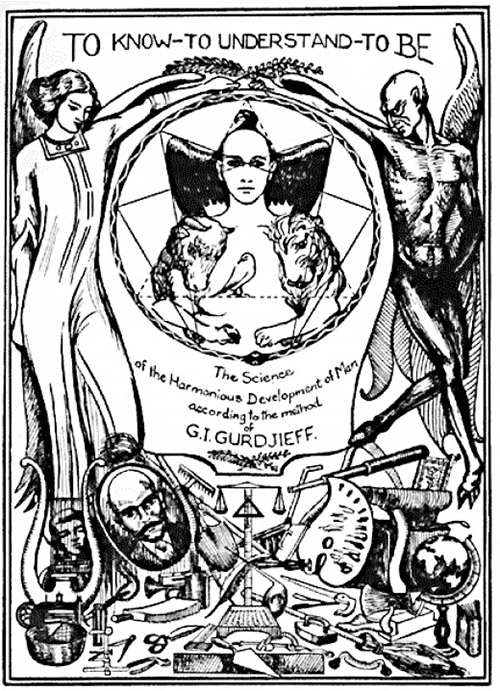
By this time Ouspensky had already ended his schooling with Gurdjieff and had set out to teach the system on his own, always giving Gurdjieff credit for it. Or at least for bringing it to the West. Gurdjieff said he had learned it during his time with the Sarmoung Brotherhood, a Central Asian version of Madame Blavatsky’s Tibetan masters, a story he tells in Meetings with Remarkable Men, the most immediately readable of his writings. But at other times Gurdjieff spoke of the system as “his,” so it is unclear how much belonged to him and how much he was “transmitting” from what he called the “inner circle of humanity.” Either way, Ouspensky had come to the conclusion that while he believed the system offered the sole method of “waking up,” he felt that he could no longer work with Gurdjieff himself.
Two Very Different Teachers
During their time together, Gurdjieff taught in a more or less traditional way, through lectures, relating ideas and various exercises or methods of fighting “sleep.” This, along with Ouspensky’s clarity and rigour as a writer and thinker, makes In Search of the Miraculous still the best introduction to “the work.” Ouspensky believed that somewhere along the line, Gurdjieff changed and that his methods and aims were no longer the same as when he first began to learn from him. They had become, as mentioned, more geared toward a kind of psychodrama or role-playing and had also become more focused on the kind of “shock tactics” familiar to one branch of “the work.” The “movements,” incredibly difficult postures and “sacred dances,” designed to outwit our mechanicalness and awaken slumbering parts of ourselves, were part of this. It also entailed making more and more of what Gurdjieff called “super-efforts,” pushing oneself beyond one’s usual limits. When Orage, a portly man and heavy smoker, arrived at Fontainebleau, he was given a shovel and told to dig. He did until his body ached and he sobbed with pain. When he felt he could no longer go on, a sudden influx of energy hit him; he had broken through his mechanical limits. Gurdjieff also made outlandish claims about the success of his Institutes in other cities, most, if not all untrue. Gurdjieff was much more of a “crazy guru” than Ouspensky, a more traditional serious philosopher. And to make things worse, in 1924, a year after it opened, except for a small group, Gurdjieff turned away practically all of his students, said the Institute was closing down, and furthermore, that hewas breaking off all relations with Ouspensky.
Exactly why teacher and student fell out remains unclear, although in my book In Search of P.D. Ouspensky, I take a stab at answering this question, the essential one in the psychohistory of “the work.” Probably the most likely reason is that they were two very different men and that whatever his faults – I don’t spare them in my book – Ouspensky had a genius of his own, as many of his readers know. However remarkable a teacher Gurdjieff was, Ouspensky could not have remained a student for very long. The strange thing is that he continued to teach the system – to which he added his own ideas about time, as spelled out in his magnum opus A New Model of the Universe – while having many troubling doubts about his teacher. One concern was reports of Gurdjieff enjoying the intimate favours of some of his students. At first Ouspensky dismissed these as gossip; later he wondered about their veracity. Gurdjieff, he knew, was no angel. Indeed, some who encountered him painted him as quite the devil. In any case, he kept everyone on their toes and Ouspensky had had enough of it.
Ouspensky taught the system in London and, during World War II, in New York and New Jersey, for some twenty-five years. Then, in a series of lectures held in London in 1947, a few months before his death, Ouspensky rejected it, telling his audience they had to think for themselves and start again from the beginning. Exactly what this meant remains one of the mysteries in the psychohistory of “the work.” Some think it was an expression of searing honesty by a man who realised he had made a mistake. Others see it as a grand “work” strategy, a “shock” sent to force people to wake up. Perhaps we will never know. Gurdjieff spent some time in New York in the 1930s, but his main base of operation, following the closing of his Institute, was Paris. There, in his small flat in the rue des Colonels-Renard, which he maintained during the Nazi occupation, he gathered his many students for enormous dinners that would last for hours, and during which he would get them drunk on vodka and pierce their personality to get to their essence. He died in 1949.
A simple way to see the difference between the two is this. Ouspensky’s approach was to create a method that could be applied by anyone with the will and determination to master it, independently of the personal power or baraka of the teacher, rather as Husserl’s phenomenological method can be learned by anyone with the necessary patience and persistence. But no one could learn how to be like Gurdjieff, although somehow his presence, which so impressed Ouspensky, was in some way able to help others to be like themselves, perhaps for the first time. We might say that Ouspensky’s was the way of knowledge, whereas Gurdjieff taught through being. And, of course, he knew some things too.
If that is the case, then we are lucky that Ouspensky laboured to capture what he learned from Gurdjieff and to present it in such a brilliant, vivid, and gripping way, as this is what remains for us today. We may not be able to benefit from Gurdjieff’s presence, but we may be able, through his and Ouspensky’s efforts, to make something of our own.
Footnotes
1. P. D. Ouspensky, In Search of the Miraculous, Harcourt Brace and Co. 1949, 3
2. Ibid.
© New Dawn Magazine and the respective author.
For our reproduction notice, click here.

